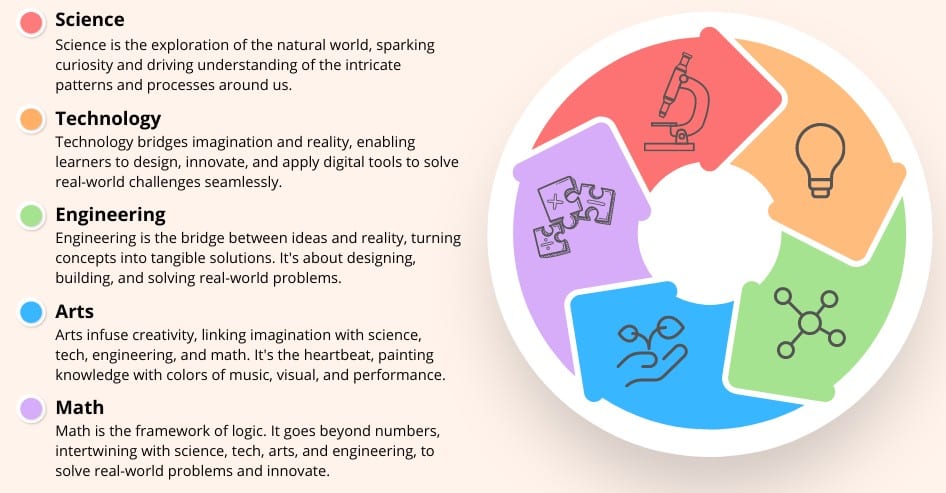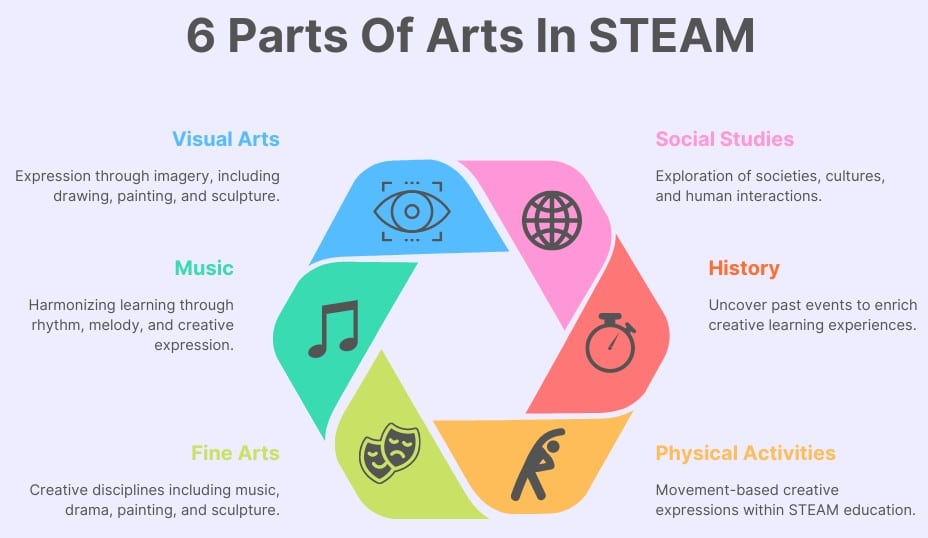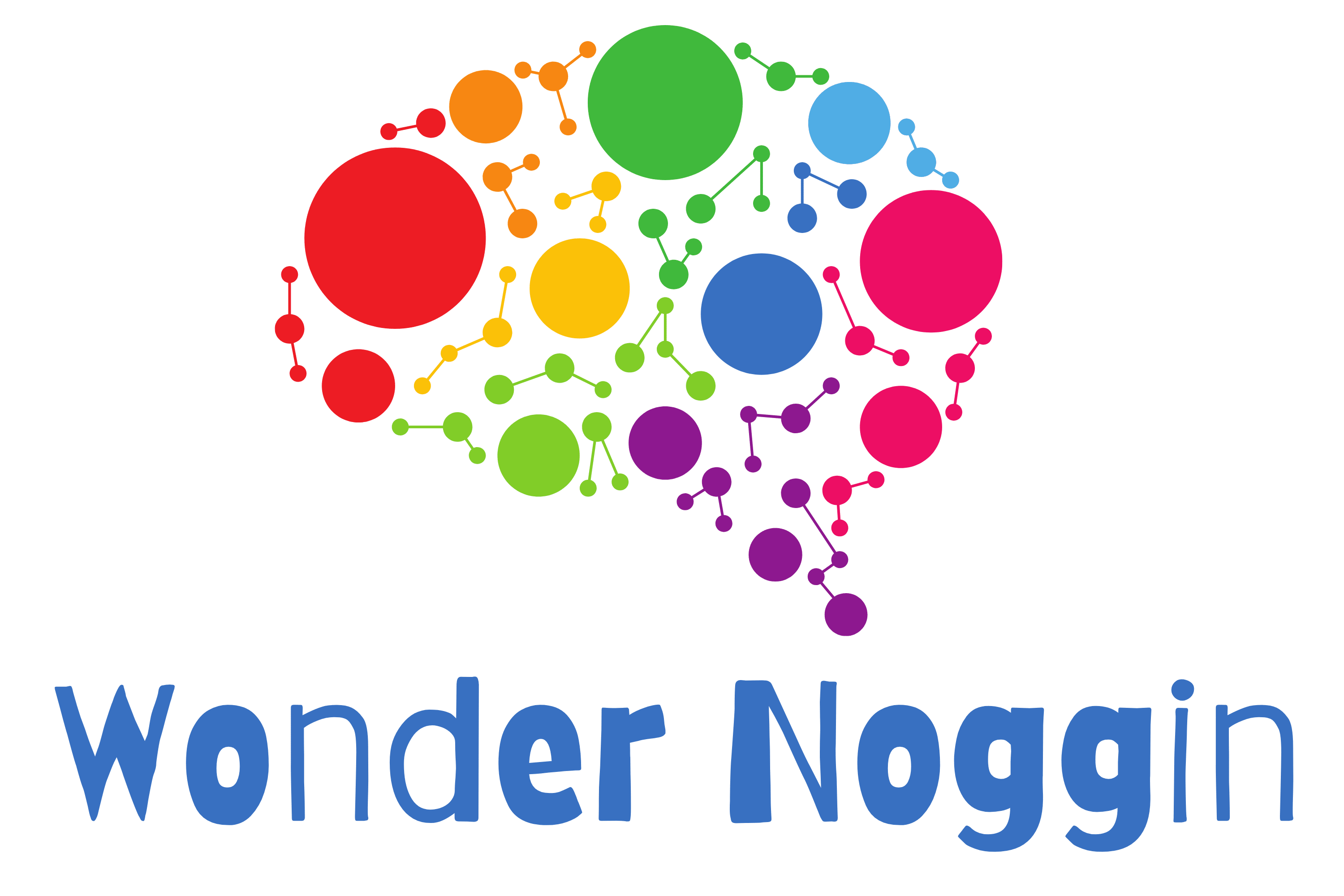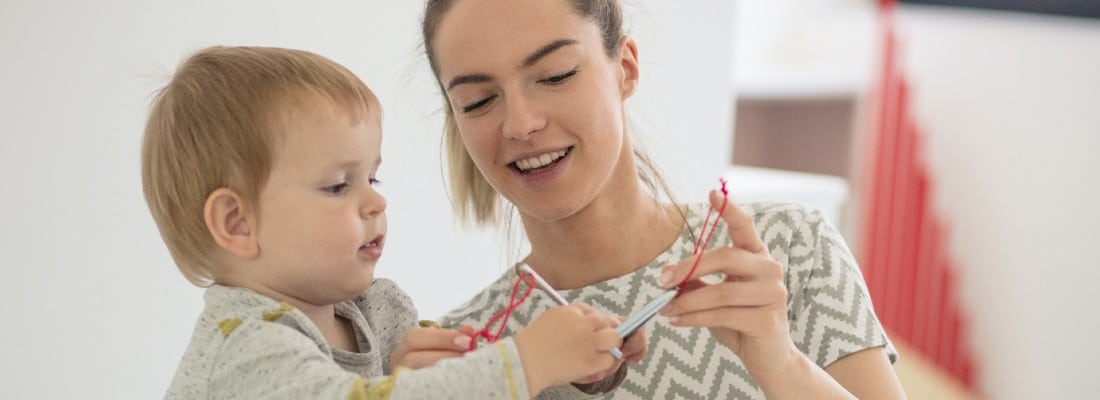Diving into the realm of STEAM with our little ones, we often resonate with the Science, Tech, Engineering, and Math components.
Yet, the ‘A’ remained a delightful mystery when thinking about what STEAM stands for – it stands for Art! Far from mere embellishments, Art is the heart of STEAM, infusing creativity into learning.
Through vibrant strokes of paint, rhythmic dances, and the drama’s magic, Art complements STEAM seamlessly.
It’s not merely about beautifying; it’s about fostering innovation and design. So, dear parents, let’s explore the wonders of Art in STEAM together, bringing vibrant learning home!
What Does The A In STEAM Stand For?
STEAM education infuses creativity into STEM tasks, sparking students’ imaginative and artistic prowess. The “A” in STEAM empowers learners to approach problem-solving inventively, striking a balance between analytical precision and innovative flair.
Many people questioned if art was necessary to enhance STEM. In response, a study from Drexel University shows how the addition of subjects outside STEM, like visual arts, physical activities, and social studies, enhanced the overall learning process.
I know my son will have an easier time learning in school and beyond because of the lessons he has picked up with our STEM projects at home, but I noticed an immediate improvement once I added arts from STEAM. I will share my findings with you in the following sections and show why arts is an important addition to STEM.

Why Was Art Added To STEAM?
In the bustling era of the early 2000s, our children’s classrooms were undergoing a quiet revolution. As the world leaned more towards a digital, technology-driven future, there grew an acute awareness among U.S. policymakers that children needed to learn about art, social studies, and language arts to fuel a future professional workforce.
It wasn’t just educators championing this cause; the government echoed the importance of the A in STEAM. With the establishment of the Congressional STEAM Caucus and the Every Student Succeeds Act of 2015, arts and music were recognized as integral components of a truly comprehensive education.
But like any transition, there were, and still are, growing pains. Schools grapple with its practical implementation without a unified framework for STEAM education.
Despite the debates on its exact definition, one thing’s for certain: the inclusion of arts recognizes the importance of nurturing both the mind’s logic and its imagination.
The Importance of the ‘A’ in STEAM
When your little one delves into art, it’s not just colors and canvases.
It’s a journey of self-expression, imagination, and creativity. Those tiny hands sculpting clay or brushing vibrant hues are also weaving dreams, building confidence, and understanding the world around them.
Here are a few of the many benefits that art offers young learners:
- Fosters Creativity: The ‘A’ encourages students to think outside the box, bringing innovative solutions to STEM challenges.
- Holistic Development: Merging arts with STEM nurtures both the logical and creative hemispheres of the brain.
- Enhanced Engagement: Incorporating art can make STEM subjects more relatable and engaging for diverse learners.
- Improves Problem-Solving: The artistic perspective can lead to multifaceted solutions, considering both function and aesthetics.
- Promotes Collaboration: The ‘A’ emphasizes interdisciplinary collaboration, teaching students the value of varied perspectives in project outcomes to solve real-world problems.
So, as you chart out your home STEAM adventures, let art be the compass. In a world buzzing with algorithms and equations, the heartbeats of our children’s creations keep the magic alive. Dive in, and watch their worlds blossom!
What Does Art Mean In STEAM?
When I first heard about art in STEAM, my mind instantly jumped to paintings and craft sessions.
But oh, how my perspective shifted!
Art in STEAM isn’t just about crayons and markers; it’s a vast universe waiting to be explored. It’s the pulse, the imagination, the bridge that melds logic with creativity.
Let’s look at what art actually means in STEAM so you can educate your child and keep your mind open to take advantage of every opportunity to support your child in their early education journey.

1. Visual Arts
In the realm of STEAM, visual arts serve as the soulful bridge connecting science, technology, engineering, and math to the human experience.
Focusing on mediums like painting and sculpting, visual arts introduce a tangible and aesthetic dimension to these traditionally logical fields. By weaving together the tactile beauty of art with the precision of STEM, visual arts amplify the emotional resonance of innovation, underscoring the intertwined nature of creativity and technical mastery.
How Visual Arts Enhances STEAM
Harnessing the power of visual arts in STEAM helps preschool and kindergarten kiddos bloom beautifully. It’s not just about colors and shapes; it’s about creating, thinking, and understanding the world in vivid ways.
- Holistic Growth: Visual arts encourage emotional, cognitive, and motor development.
- Creativity Boost: Painting and drawing foster imagination and innovative thinking.
- Spatial Skills: Manipulating art materials can enhance spatial understanding.
- Cultural Awareness: Through art, kids learn about different cultures and perspectives.
- Problem-Solving: Creating art helps little ones tackle challenges and think critically.
How To Teach Visual Arts At Home
There are opportunities all around you that you can use to teach your little ones about visual arts as part of STEAM art educational programs at home. Here are five quick ideas that you can use:
- Free Play Exploration: Provide a variety of art materials like crayons, paper, clay, and markers. Encourage open-ended creativity, letting them experiment and express themselves through drawing, molding, and coloring at home during weekends.
- Nature Art Walk: Take a walk in the park, garden, or forest on a sunny afternoon. Encourage kids to collect leaves, flowers, and rocks. Later, use these natural elements for collage art projects at home.
- Storybook Illustrations: Before bedtime, read a favorite storybook together. Afterward, ask them to draw their favorite scenes or create their version of the characters using colors and imagination.
- Shape and Color Hunt: Pick a day for a shape and color scavenger hunt around the house or neighborhood. Guide kids to spot and capture various shapes and colors, then create a collage or mosaic art at home.
- Family Art Gallery: Designate a wall at home as a “Family Art Gallery.” Encourage each family member to create art pieces during the week, then display and discuss their artworks together during a weekend art exhibition.
You can integrate visual arts into STEAM education for preschoolers and kindergarteners, fostering creativity, critical thinking, and foundational skills for holistic development.
2. Social Studies
When thinking about the A in STEAM, one concept I found interesting was social studies which intertwine history, culture, and society with innovative disciplines.
While visual arts like painting or sculpting express human emotions, social studies provide the backdrop, elucidating the societal contexts and cultural narratives.
Within STEAM, social studies act as a bridge, linking past and present, ensuring that as we forge ahead with science, technology, engineering, and math, we remain deeply rooted in our shared human story.
How Social Studies Enhances STEAM
Blending social studies into STEAM for preschoolers and kindergarteners unlocks doors to diverse worlds. It’s not just about places; it’s about people, traditions, and heartwarming connections.
- Community Awareness: Grasping the basics of society and roles.
- Global Mindset: Introducing diverse cultures and lifestyles.
- Moral Foundations: Understanding rights, values, and responsibilities.
- Problem-Solving: Navigating social situations and relationships.
- Map Skills: Starting early with geographical exploration and orientation.
How To Teach Social Studies At Home
Here are some ideas to help you introduce social studies as part of STEAM art around your home.
- Cultural Collage: Help kids create a collage using images and symbols representing diverse cultures. Discuss different traditions and customs while cutting and pasting. Ideal for weekends, setting up a cozy art corner.
- Map Murals: Engage children in painting a world or neighborhood map on a large sheet. Talk about continents, countries, and landmarks during art sessions. Perfect for holidays or rainy afternoons at home.
- Community Helpers Puppets: Design and make finger puppets of community helpers like firefighters, doctors, and police officers. Act out scenarios to learn about roles in society. Fun for playdates or educational playtime.
- Time Travel Diorama: Encourage constructing a time travel diorama with figures from the past and present. Compare lifestyles, transportation, and clothing to introduce history topics. Great for long weekends or school breaks.
- Monuments in Clay: Mold famous monuments worldwide using clay or playdough. Explore architectural wonders and discuss their significance. An educational activity after a family vacation or during school holidays.
Integrating social studies into STEAM through art offers parents dynamic tools to foster holistic understanding, cultivating both creativity and cultural awareness in preschoolers and kindergarteners.
3. History
History, within the STEAM framework, provides context and perspective. It’s the story behind each scientific breakthrough, every engineering marvel, and all artistic masterpieces.
By studying history, children understand the evolution of ideas, the interplay of culture and invention, and the resilience of pioneers in various fields.
In STEAM, history isn’t just about dates; it’s about the journey of human progress, offering inspiration and STEAM lessons for young, inquisitive minds at home.
How History Enhances STEAM
Infusing history into STEAM for our preschool and kindergarten stars is like gifting them a time machine. It’s about connections, understanding, and embracing the tales of yesteryears.
- Building Empathy: Learning past stories helps kids relate and feel.
- Critical Thinking: History prompts questions and curiosity.
- Cultural Appreciation: Discovering diverse pasts enriches worldviews.
- Patterns & Predictions: Recognizing historical patterns aids in making predictions.
- Narrative Skills: Storytelling strengthens communication and comprehension.
How To Teach History At Home
It can be difficult to find ways to teach history at home, but here are some ways I like to weave STEM in everyday life with various history activities.
- Historical Artifacts Collage: Gather pictures of artifacts like ancient pottery or medieval armor. Help kids create a collage using recycled materials to mimic the artifacts’ textures and shapes. Teach during a museum visit or after reading a history storybook.
- Time Travel Self-Portraits: Have kids draw self-portraits imagining themselves in different historical eras. Provide historical context and discuss clothing, customs, and architecture. Teach during bedtime stories or after watching a historical animated film.
- Monuments and Landmarks Painting: Introduce famous historical monuments and landmarks. Encourage kids to paint them with vibrant colors, exploring artistic expression while learning about their significance. Teach during family trips or virtual tours of landmarks.
- Cave Painting Reenactment: Teach about prehistoric times and cave paintings. Set up a “cave” (blanket fort) and let kids draw with homemade natural paints like berries. Discuss early human life during camping or nature outings.
- Storytelling Through Puppets: Help children create historical finger puppets representing characters from different periods. Act out stories based on historical events, fostering creativity while understanding past cultures. Teach during playtime or on rainy afternoons.
Integrating history with art in STEAM enriches early education, offering parents a multidimensional approach to instilling a love for the past in preschoolers and kindergarteners.
4. Physical Activities
Physical activities in the context of STEAM integrate movement, performance, and tactile experiences into learning. It encompasses STEAM activities like dance, theater, and hands-on crafting.
When applied in STEAM, physical activities engage children in a dynamic manner, marrying bodily kinesthetics with scientific principles. For parents teaching STEAM at home, incorporating physical activities can ignite a child’s curiosity, ensuring learning is not just intellectual but also an engaging, sensory-rich experience.
Why Physical Activities Enhances STEAM
Incorporating physical activities into STEAM for our preschool and kindergarten darlings is pure magic. It’s more than just movement; it’s about expressing, growing, and embracing the rhythm of learning.
- Motor Skills: Perfecting balance, coordination, and agility.
- Emotional Expression: Dancing and acting out feelings.
- Teamwork: Group activities nurture cooperation and sharing.
- Pattern Recognition: Following sequences in dance and movements.
- Confidence Boost: Performing builds self-esteem and courage.
How To Teach Physical Activities At Home
Movement and physical activity is important for young learners. Not only does physical activity help children develop motor skills, it also gets extra energy out and can improve their attention span. Here are some ways I like to use physical activities in our daily routine:
- Movement Painting: Encourage kids to use their bodies to create art by painting with their feet, hands, or whole body on large sheets of paper outdoors. Choose a sunny day in the backyard for an interactive art session.
- Nature Sculptures: Take a nature walk with your child, collecting leaves, sticks, and stones. Back home, create sculptures by arranging these items into imaginative forms and shapes. This activity enhances creativity and appreciation for the environment.
- Dance Party: Organize a dance party in the living room, where kids can express themselves through movement to different styles of music. Play upbeat tunes and encourage them to explore various dance styles.
- Shadow Play: Use a flashlight and a white sheet to create shadow puppetry. Guide children to make characters and tell stories using shadows on the sheet. This fosters storytelling skills and stimulates the imagination.
- Obstacle Course: Set up a simple obstacle course in the backyard using hula hoops, cones, and cushions. Have kids navigate through the course, improving their balance, coordination, and motor skills. Make it a fun family challenge on weekends.
Integrating physical activities into STEAM education for preschoolers and kindergarteners enriches their learning experience, fostering creativity, motor skills, and a holistic understanding of the world around them.
5. Fine Arts
Fine arts in the realm of STEAM melds creativity with critical thinking. It’s not just about traditional practices like painting or sculpture; it’s about how these artistic expressions interact with science, technology, engineering, and math.
For parents teaching STEAM at home, introducing fine arts means fostering a holistic approach. It’s the bridge that links analytical skills with imaginative exploration, nurturing well-rounded, innovative young minds ready to face tomorrow’s challenges.
How Fine Arts Enhances STEAM
Weaving fine arts into STEAM for our preschool and kindergarten gems unveils worlds of color, texture, and passion. It’s beyond brushstrokes; it’s a journey of discovery, creativity, and pure joy.
- Sensory Exploration: Experiencing various textures and materials.
- Motor Precision: Fine-tuning hand-eye coordination.
- Self-Expression: Portraying emotions and imagination on canvas.
- Patience & Focus: Engaging in detailed, step-by-step projects.
- Artistic Appreciation: Cultivating a love for beauty and artistry.
How To Teach Fine Arts At Home
Fine arts is an important part of art in STEAM, and here are a few ways to encourage your little learners to stay ahead with fine arts in STEAM education:
- Craft Time Creations: Use household items to create simple art projects. This fosters motor skills and creativity while teaching about recycling. Ideal during after-school hours or weekends for hands-on, focused attention.
- Color Exploration: Teach color theory using paints and crayons, reinforcing knowledge about primary and secondary colors. Combine it with a nature walk to identify colors in the environment. Perfect for weekend outings or sunny afternoons.
- Pattern Play: Use art to explore patterns and sequences. Draw or paint patterns, encouraging your child to continue them. Great for morning or evening activity time, blending art with early math skills.
- Story Illustration: Let your child draw or paint their favorite story, fostering narrative understanding and visual expression. Best suited for quiet evenings or rainy day activities.
- Sensory Art: Use different materials (sand, clay, fabric) to create tactile art. This expands sensory experiences and artistic exploration. A perfect weekend activity to get messy and have fun while learning.
Incorporating fine arts into STEAM for preschoolers and kindergarteners enriches learning, fostering creativity and holistic development in early childhood education. Parents play a pivotal role in this artistic journey.
6. Music
Music arts in the context of STEAM are a symphony of creativity and analytical thinking. Music, beyond its melodious charm, reveals patterns, frequencies, and rhythms akin to mathematical equations, and there are many benefits to learning through music.
In STEAM, music arts act as a bridge, fostering a deeper understanding of science, technology, engineering, and math concepts. For parents teaching STEAM at home, music offers an engaging avenue to inspire young minds, merging emotion with intellect in a harmonious dance of learning.
How Music Enhances STEAM
Weaving music into STEAM for our preschool and kindergarten gems lights up their world. It’s beyond tunes; it’s rhythm, harmony, and the soulful dance of learning.
- Listening Skills: Tuning into different sounds and nuances.
- Math Connections: Counting beats and understanding patterns.
- Emotional Resonance: Expressing and recognizing feelings through sound.
- Memory Boost: Remembering lyrics and melodies sharpens recall.
- Cultural Exploration: Diving into diverse musical traditions and histories.
How To Teach Music At Home
Music is a great addition to STEAM through art because music helps kids express themselves and learn mat at the same time. Here are a few ways I like to include music in our daily activities while at home:
- Sing-along Fun: Engage in interactive singing sessions during playtime or bedtime, introducing basic music notes and rhythms. Use simple instruments like tambourines or shakers to explore beat and tempo.
- Nature’s Music: Take outdoor walks and listen to sounds in nature – birds chirping, leaves rustling. Encourage kids to mimic these sounds using their voices or create improvised musical compositions together.
- DIY Instrument Making: Utilize household items to craft DIY instruments like paper plate drums, rubber band guitars, or water bottle maracas. Experiment with different sounds and encourage kids to compose their melodies on a toddler drum kit or one of the many rhythm games for kids.
- Musical Storytime: Introduce musical books that incorporate songs or rhythms. After reading, recreate the story’s musical elements together. This enhances literacy skills and introduces the concept of storytelling through sound.
- Dance Party STEAM: Organize dance parties where kids can freely move and express themselves to various music styles. Connect dance to emotions and discuss how body movements can convey feelings through music.
Music arts integration into STEAM education for preschoolers and kindergarteners enriches their learning, fostering creativity and holistic development through diverse artistic avenues.
Putting The A In STEAM
The ‘A’ in STEAM is so much more than just another letter—it’s the heart that gives life to the other elements.
It represents ‘Arts’, a vital component that fosters creativity, expression, and a holistic understanding of the world.
In a world heavily leaning on Science, Technology, Engineering, and Math, the arts ensure that we don’t lose sight of our humanity, our emotions, and our innate ability to connect with one another.
Just as we guide our children to tackle math problems or explore the wonders of science, let’s encourage them to paint, dance, sing, and imagine. Because in the grand tapestry of learning and growth, it’s not just about producing future engineers or scientists but nurturing well-rounded, compassionate individuals.
Embracing the ‘A’ in STEAM is a beautiful reminder of this. Let’s celebrate the harmony it brings!







0 Comments